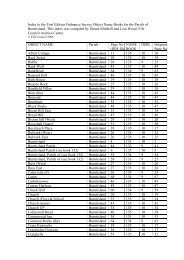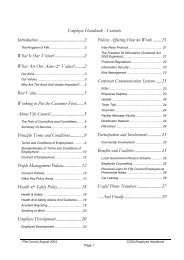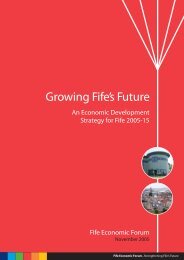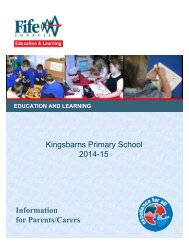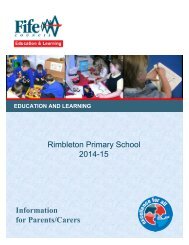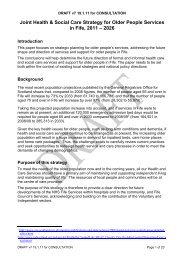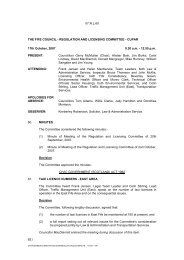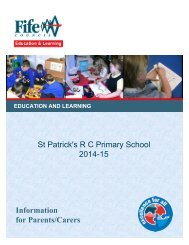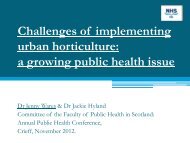Fife Local Biodiversity Action Plan - Home Page
Fife Local Biodiversity Action Plan - Home Page
Fife Local Biodiversity Action Plan - Home Page
Create successful ePaper yourself
Turn your PDF publications into a flip-book with our unique Google optimized e-Paper software.
<strong>Fife</strong> <strong>Local</strong> <strong>Biodiversity</strong> <strong>Action</strong> <strong>Plan</strong>2nd Edition2003-2006
The <strong>Fife</strong> <strong>Local</strong> <strong>Biodiversity</strong> <strong>Action</strong> <strong>Plan</strong> 3Foreword<strong>Fife</strong> has a proud heritage of action for biodiversity. The inception of <strong>Fife</strong>’sbiodiversity process in 1997 brought together a rich assemblage of bothprofessional and voluntary environmental workers, each willing to work towardsthe goals laid down in the 1st edition of <strong>Fife</strong>’s <strong>Local</strong> <strong>Biodiversity</strong> <strong>Action</strong> <strong>Plan</strong>(LBAP).Since that time, a huge effort has been made by the involved organisations, whichhas ensured a significant amount of progress has been made towards reachingthe LBAP’s goals. This is exemplified by the action plans now written and thepractical projects either completed or underway - from river enhancement to urbanwildflower planting, and from working with business to providing free nestboxmaterials for community groups.This edition of the LBAP reflects the previous effortput into the LBAP, and looks towards the actionsplanned for the next three years. The <strong>Fife</strong> LBAP isnow focusing on farmland, urban, coastal andrivers, priorities that were chosen through extensiveconsultation and consideration of <strong>Fife</strong>-wideenvironmental action. Indeed, the LBAP is now fullyintegrated with the Take a Pride in <strong>Fife</strong> Strategy, theenvironmental theme of <strong>Fife</strong>’s Community <strong>Plan</strong>.This edition of the <strong>Fife</strong> LBAP marks an excitingpoint in <strong>Fife</strong>’s biodiversity action. It signifiesrenewed focus and energy. As the LBAP isimplemented, local biodiversity will beeffectively supported, whilst contributions willalso be made towards the conservation andenhancement of UK biodiversity priorities.Of course, the action planned for biodiversitycan be implemented not just by organisations,but also by the people of <strong>Fife</strong>. I hope you willjoin us in our eff o rts to sustain <strong>Fife</strong>’sbiodiversity, and in looking forward to theoutcome of our next three years of action.Chair, <strong>Fife</strong> <strong>Biodiversity</strong> Partnership
The <strong>Fife</strong> <strong>Local</strong> <strong>Biodiversity</strong> <strong>Action</strong> <strong>Plan</strong> 5ContentsIntroduction 7The <strong>Biodiversity</strong> of <strong>Fife</strong> 8The <strong>Fife</strong> LBAP – Turning <strong>Plan</strong>s into <strong>Action</strong> 9Farmland Core Project 10Urban Core Project 12Coastal Fringe Core Project 14Rivers Core Project 16Monitoring and Information Core Project 18Be Part of the <strong>Biodiversity</strong> <strong>Action</strong> 20AppendicesAppendix 1: Contact Information 22Appendix 2: <strong>Fife</strong>’s Habitat and Species <strong>Action</strong> <strong>Plan</strong> 25Appendix 3:The Rural Stewardship Scheme <strong>Fife</strong> 30 List 26Appendix 4: The <strong>Fife</strong> <strong>Biodiversity</strong> Partnership 27Appendix 5: Further Reading 27©ECOSAcknowledgements 28
8 The <strong>Fife</strong> <strong>Local</strong> <strong>Biodiversity</strong> <strong>Action</strong> <strong>Plan</strong>The <strong>Biodiversity</strong> of <strong>Fife</strong><strong>Fife</strong> is recognised as an area with a picturesque natural heritage - from the stunningcoastline scenery, to the windswept Lomond Hills and the rolling agricultural fieldsof the east. <strong>Fife</strong>’s natural heritage is also extremely diverse, partly as a result of theinfluence of coastal factors and the surrounding major mountain ranges of theHighlands and the Southern Uplands.Another influential feature of <strong>Fife</strong> is its geodiversity:the geological features and landforms which shapenot only <strong>Fife</strong>’s landscape, but also its soils, mineralre s o u rces and habitats. These characteristics of <strong>Fife</strong>combine to produce a region with a richly variedt a p e s t ry of habitats, where a wide variety of species can live.The highest point in <strong>Fife</strong> is found in the Lomond Hills.A wide assortment of habitats are found in theLomonds, including the majority of <strong>Fife</strong>’s moorlandand heath, along with grasslands, mires and open water. <strong>Fife</strong> stretches from the hillst h rough ancient woodlands, lowland raised bogs, grasslands and wetlands downto the coast. <strong>Fife</strong> is a penisula bord e red by two large estuaries, the Forth and Ta y,and the North Sea to the east. <strong>Fife</strong>’s river system comprises three main rivers (theLeven, Eden and Ore) and numerous burns. Each of these rivers flow thoughanother important habitat –the urban and built environment, where many gre e nplaces and parks provide homes for lotsof the most common and best loved ofF i f e ’s species.©Forestry CommissionIn fact about 10,000 species of animals, plants, butterflies, birds andinsects occupy the diff e rent habitats of <strong>Fife</strong>. These include every t h i n gf rom the Otters, Corn Buntings and Coralroot Orchids of our wilderplaces, to the Blue Tits and Common Frogs found in back gard e n sa c ross <strong>Fife</strong>.
The <strong>Fife</strong> <strong>Local</strong> <strong>Biodiversity</strong> <strong>Action</strong> <strong>Plan</strong> 9The <strong>Fife</strong> LBAPTu rning <strong>Plan</strong>s into <strong>Action</strong>The first edition of <strong>Fife</strong>’s LBAP was published in 1997. In 2001, it was agreed bythe <strong>Biodiversity</strong> Partnership that the LBAP should be reviewed, and a new appro a c hto its implementation developed. This new approach began with a review of thet a rgets contained within the habitat and species action plans written as part of thefirst edition of the LBAP. These were put together and sent out for review by eachmember of the <strong>Biodiversity</strong> Partnership.F rom this re v i e w, five main areas of work were clearly identified: farmland, urban,coastal fringe, rivers and monitoring and information. The next step was to writep roject plans for each of these core work areas, including specific targets for eachto be implemented over the next three years. These plans were based on LBAPt a rgets from relevant HAPs and SAPs and ongoing biodiversity action in <strong>Fife</strong>,including actions agreed to by organisations involved in the FEN Take a Pride in<strong>Fife</strong> Strategy.©Forestry CommissionThe purpose of these core projects is to provide a focus for LBAP action and forwider biodiversity projects across <strong>Fife</strong>. Each project will bring existing initiativestogether and work to develop a co-ordinated approach across the manyo rganisations currently involved. The core projects should be seen as an umbre l l afor many diff e rent initiatives, which may either develop directly from the LBAP, or mayinvolve the LBAP in ongoing action. This broad-based approach will also incre a s ethe LBAP’s access to funding, as a result of the wider impact that each project willh a v e .©ECOSIt is critical to monitor these projects as they are implemented, and a monitoring andi n f o rmation core project is underway to ensure this happens. This project will meetthe needs of monitoring biodiversity action in <strong>Fife</strong> and the impact it is having on <strong>Fife</strong>’sb i o d i v e r s i t y. It will also provide information for national monitoring of UK biodiversitypriorities and <strong>Fife</strong> Council’s Community <strong>Plan</strong>re p o rt i n g .The process of implementing the five core projects will meet many of the specifict a rgets listed in the LBAP’s habitat and species action plans, and ensure the LBAPreaches the goals laid out in the 1997 edition.As the LBAP is implemented, an update of its pro g ress will be published annually ina newsletter. This will be distributed to the public, and will be available on the <strong>Fife</strong>D i rect website (www. f i f e d i re c t . o rg.uk, then go to Around <strong>Fife</strong> > Natural <strong>Fife</strong> >B i o d i v e r s i t y, or search for ‘biodiversity’). Following three years of implementation, theLBAP and its impact on <strong>Fife</strong>’s biodiversity will be reviewed and its priorities adjustedif necessary.In the following pages you can find out about the LBAP’s core projects and find outhow you can get involved.
1 0 The <strong>Fife</strong> <strong>Local</strong> <strong>Biodiversity</strong> <strong>Action</strong> <strong>Plan</strong>Farmland Core ProjectIntroductionFarmland is an important part of <strong>Fife</strong>, making up about 75% of <strong>Fife</strong>’s land space.Farming is therefore not only a major industry, but it also provides a vital habitatfor many of <strong>Fife</strong>’s bird, plant and animal species.Ongoing actionThere are currently a number of initiatives targeting farmland bird specieshappening throughout <strong>Fife</strong>. While these initiatives focus mainly on Corn Buntingsand Tree Sparrows, they will produce benefits for many other related farmlandhabitats and species.©ECOS• Farmland Bird Lifeline (RSPB Scotland, <strong>Fife</strong> and Kinross Farming and WildlifeAdvisory Group)This three year project began in 2002 and focuses on the <strong>Fife</strong>’s important CornBunting population. Corn Buntings were common in <strong>Fife</strong>, but are now onlyfound in a few areas, particularly the East Neuk. Five <strong>Fife</strong> farmers are workingwith RSPB Scotland to create the farmland features that could help this birdthrive again.©RSPB Images• BirdAid (RSPB Scotland)The populations of many seed-eating farmland songbirds have declined. ThisUK-wide research project examines the effects of providing an abundant sourceof winter food for two of these songbirds: Corn Buntings and Tree Sparrows.• School Tree Sparrow Project (RSPB Scotland)RSPB teacher naturalists are working with six <strong>Fife</strong> schools to complete farmlandbird coursework and construct nest boxes for Tree Sparrows, which have beenput up on local farms.©RSPB Images• Volunteer and Farmer Alliance (RSPB Scotland)This project provides farmers with a free confidential survey of the birds on theirfarm, completed by RSPB volunteers. Farmers receive a laminated map of thesurvey results, including details of the birds found.• Operation Lapwing (RSPB Scotland)Land managers can become ‘Lapwing champions’ through this project, whichalso provides advice on how to encourage Lapwings to visit their land.• Grey Partridge Recovery Project and Count Scheme (Game Conservancy TrustScotland)• LEAF (Linking Environment and Farming) have an active farm in <strong>Fife</strong>, where over300 people have visited in the last two years to learn more about farming andthe environment.©RSPB Images• The Rural Stewardship Scheme (RSS) is a government initiative, which providespayments to farmers who carry out sensitive management of their land. In theirapplication to be included in the scheme, farmers are awarded points relativeto the habitats and species present on their farm. Each area of Scotland has a‘30 List’ of habitats and species for which points are awarded. This list is basedon the habitats and species included in each area’s LBAP, and the <strong>Fife</strong><strong>Biodiversity</strong> Partnership updates <strong>Fife</strong>’s 30 List as required.
The <strong>Fife</strong> <strong>Local</strong> <strong>Biodiversity</strong> <strong>Action</strong> <strong>Plan</strong> 1 1Long-term goals• Enhance farmland and farming practices for the benefit of biodiversity and the farming community.• Work with local communities to ensure integration of biodiversity with farming practices.ACTION LEAD O RGAN ISATION COM PLETI ONCreate a project group to develop a co-ordinated RSPB Scotland 2003approach to implementing farmland projects in <strong>Fife</strong>.Utilise experience from current, ongoing action (see RSPB Scotland and 2003-2006above) to develop such projects project group on aproject groupwider scale – especially in eastern <strong>Fife</strong> to help conserveCorn Buntings and other farmland wildlife.Increase the availability of nest sites for Barn Owls by LBAP 2003-2004providing 100 free nestboxes.Survey these nestboxes for breeding success. LBAP 2005Provide information on wading farmland birds from LBAP 2003 onwards.existing library to farmers involved in LBAP projects.Develop a Tree Sparrow project promoting farming LBAP/RSPB Scotland 2003-2006measures, winter feeding and nest boxes to benefit thisspecies.Increase number of <strong>Fife</strong> farms counting Grey Partridge Game Conservancy Trust 2010for the national monitoring scheme. Based on results ofthis scheme, halt decline of population and increase toprevious size.Update Rural Stewardship Scheme 30 List as required. LBAP 2003-2006
1 2 The <strong>Fife</strong> <strong>Local</strong> <strong>Biodiversity</strong> <strong>Action</strong> <strong>Plan</strong>Urban Core ProjectIntroductionUrban environments account for about 10% of <strong>Fife</strong>, and take in a number ofhabitats, from greenspace and parks to watercourses and gardens. Urbanenvironments such as these are the most accessible part of <strong>Fife</strong>’s natural heritageto the majority of <strong>Fife</strong>’s population.Projects based in urban areas will promote greater public environmentalawareness and responsibility for the environment, whilst also increasing quality oflife through improved access to the benefits of biodiversity.©SNHOngoing <strong>Action</strong>There are many projects being undertaken within the community aimed atimproving the environmental and wildlife value of <strong>Fife</strong>’s towns and villages,including:• Conservation and Management <strong>Plan</strong> for Aberdour, prepared by the localCommunity Council.• Townhill <strong>Biodiversity</strong> Project, where the LBAP and <strong>Fife</strong> Ranger Service areworking with ScottishPower to implement biodiversity measures on their landaround Townhill Substation.• Beveridge Park, Kirkcaldy, where the local community will be involved inplanting wildflowers and erecting nest boxes to enhance the park’s biodiversity.• Access improvements at Dalbeath Marsh have made it easier for the localcommunity to realise the potential of this site as an outdoor resource.• Wide ranging environmental projects carried out by the Robert Gough Centre,<strong>Fife</strong> Air Cadets Conservation Group and Kelty local community.• Craigencalt Farm Ecology Centre who provide environmental education,promote urban conservation and offer advice to communities who wish toimprove their environment.• Grounds for Learning schemes in schools across <strong>Fife</strong> which have promoted theimprovement and sustainable development, management and use of <strong>Fife</strong>’sschool grounds as an outdoor learning resource.• <strong>Fife</strong> Council’s ‘Natural Connections’ programme, which promotes wild spacein urban areas as an educational resource to inform communities about localwildlife in the context of the wider environment. The programme alsoincorporates a ‘caring for nature’ theme and includes nature studies, wildlifesurveys and practical nature conservation.• <strong>Fife</strong> Council continues to play an important role in the protection of the region’surban habitats, most notably through planning policies contained in the localplans.Long term goals• Protect urban sites important for wildlife from changes in land use.• Increase the number of households living within 10 minutes walk of an attractivegreenspace.• Raise awareness amongst the general public of the importance and value ofurban biodiversity.• Encourage communities to survey, plan and manage urban wildlife habitats.• Ensure the conservation and enhancement of wildlife is incorporated into themanagement of urban greenspace.©RSPB Images
The <strong>Fife</strong> <strong>Local</strong> <strong>Biodiversity</strong> <strong>Action</strong> <strong>Plan</strong> 1 3ACTION LEAD ORGANISATION DATE TO BECOMPLETEDIdentify suitable areas for urban biodiversity projects LBAP/FERN 2003through consultation with communities and workingwith the <strong>Fife</strong> Environmental Recording Network(FERN) to make use of data from recent urban habitatsurveys.Promote and develop local area or town biodiversity LBAP/Community Councils 2003-06action plans with communities, developing theDunfermline Eastern Expansion Site as an example.Work with the <strong>Biodiversity</strong> Partnership, businesses and LBAP 2003-2006other organisations to promote biodiversity and waysin which it can be integrated into business, e.g.through environmental management systems, actionand development plans and practical managementof their land.Investigate the potential to include biodiversity LBAP/<strong>Fife</strong> Council Community 2003-2006considerations within the Best Kept Villages/Towns Services.Scheme. If biodiversity can be included, help todevelop the scheme to reflect this issue.Contribute to the quality of the local environment <strong>Fife</strong> Council Community Services 2003-2006though a range of environmental improvementprojects in partnership with local communities.Determine sustainable levels of open space through a <strong>Fife</strong> Council Community Services 2004'Parks and Open Space Strategy'.Investigate the feasibility, promote and action the <strong>Fife</strong> Council Community Services 2006setting up of urban green recreation/play areas,aiming to produce one pilot site by 2006.Produce and implement landscape plans for the <strong>Fife</strong> Council Development Service 2003-06countryside around settlements. These plans will:• Inform the preparation of development plans(Structure and <strong>Local</strong> <strong>Plan</strong>s).• Provide a local context for landscape.• Assist in management and enhancement oflandscape setting and improve access tosurrounding countryside.
1 4 The <strong>Fife</strong> <strong>Local</strong> <strong>Biodiversity</strong> <strong>Action</strong> <strong>Plan</strong>Coastal Fringe Core ProjectIntroductionWith a length of 170 km, the <strong>Fife</strong> coast and its surroundings are anenormous resource for wildlife. Indeed, a large proportion of <strong>Fife</strong>’simportant species and habitats are found in and around the coastal fringe.Along with beaches and rocky shore, the coast includes a range ofterrestrial habitats such as grasslands and dunes, as well as the sea itself.The coast is a popular place for countryside recreation and tourism and itis important this is integrated with biodiversity. <strong>Biodiversity</strong> plays a key rolein providing a quality visitor experience.Much of the coastal fringe is now designated, as part of the effort to protectfragile coastal environments from the combined pressure of development,recreation and the potential increase in sea levels.Ongoing <strong>Action</strong>There are a number of initiatives happening around the <strong>Fife</strong> coast, which aim to enhance the quality of thecoastal environment and its ability to support both biodiversity and recreation.• <strong>Fife</strong> Coastal Path (<strong>Fife</strong> Coast and Countryside Trust / <strong>Fife</strong>Council)This is an ongoing project to provide a path and series ofcircular routes around the <strong>Fife</strong> coast. A great deal of associatedfootpath works and interpretation is ongoing. A key part of thiswork is ensuring that path network integrates with and helps tomanage pressure on coastal habitats.• Beach Management (<strong>Fife</strong> Council)<strong>Fife</strong> is at the forefront of beach management in Scotland and is taking part in number UK initiatives topromote sustainable use of coastal and marine environments. This includes the piloting of the ENCAMSBeach Management Programme, which has at its core healthy coastal habitats and a safe, secure andenjoyable environment.• Nortrail – North Sea Coastal Path (<strong>Fife</strong> Council / <strong>Fife</strong> Coast & Countryside Trust)Nortrail is a joint project involving partners from eight European countries. The project aims to enhanceemployment opportunities and raise awareness of the coastal fringe through the sustainable management ofa network of landscapes and pathways, linking areas and sites of cultural and natural heritage interest.Long term goals• Promote the <strong>Fife</strong> coast as a series of interlinked, biodiverse habitats.• Provide a first class visitor experience with excellent public access andfacilities based around a high quality, clean environment. This willdemonstrate how biodiversity can be integrated and enhanced within thesocial, cultural and economic framework of society.
The <strong>Fife</strong> <strong>Local</strong> <strong>Biodiversity</strong> <strong>Action</strong> <strong>Plan</strong> 1 5ACTION LEAD O RGAN ISATION COM PLETI ONCreate large-scale environmental zones integrated <strong>Fife</strong> Council Community Services 2003-2006with other issues such as coastal zone management,access, nature conservation and beach management.Initially a framework will be developed and a pilotarea decided upon.Encourage communities on the Forth Estuary coast <strong>Fife</strong> Council Community Services 2003to take part in the Forth Estuary Forum CoastalLitter Campaign, designed to raise awareness ofmarine litter and provide opportunities forvolunteers to help improve the beach environment.Develop the cultural and natural heritage and <strong>Fife</strong> Council Community Services to be completed byeconomic opportunities along <strong>Fife</strong> Coastal Path 2007through working with local communities andparticipating in the NAVE Nortrail Trans-nationalproject, linking paths around the North Sea.
1 6 The <strong>Fife</strong> <strong>Local</strong> <strong>Biodiversity</strong> <strong>Action</strong> <strong>Plan</strong>Rivers Core ProjectIntroduction<strong>Fife</strong>’s three main inland rivers (River Eden, River Ore and River Leven) and theland they flow through provide habitat for many locally and nationally importantspecies, including Otter, Kingfisher, Water Vole, Salmon, Brown Trout and FanleavedWater Crowfoot.Ongoing action• Water Voles are currently considered to be Britain’s most threatened mammal.Their population has decreased in recent years as a result of changes to WaterVole habitat (e.g. through culverting and bank maintenance) and the invasionof feral American Mink.• The <strong>Fife</strong> LBAP River Enhancement Project is a river habitat enhancement andmink control project currently taking place in and around Lochore MeadowsCountry Park. The combined benefits of reducing the mink population andimplementing practical habitat enhancement will ensure there is suitable habitatwhere the <strong>Fife</strong> water vole population can thrive.©SEPA• The <strong>Fife</strong> and Kinro s sF a rming and Wi l d l i f eAdvisory Group (FWAG) RiverEden Project, which workswith <strong>Fife</strong>’s farming communityto decrease pollution of theRiver Eden and its catchment.Practical actions carried outwith the farming communityinclude providing new fencingto keep livestock away from the bankside, tree planting toreduce erosion and the creation of buffer zones along thewatercourses. All of these actions will reduce nutrientenrichment of the watercourses and therefore enhance themfor biodiversity.• Scottish Environment Protection Agency (SEPA) works with the farming community to reduce pollution fromfarming.Long term goals• To improve the extent and quality of river habitat in <strong>Fife</strong>.• To help maintain or improve water quality in <strong>Fife</strong>’s three main riversystems, in line with SEPA’s target of 66% of monitore dwatercourses to be of fair quality or better by 2006.©SNH
The <strong>Fife</strong> <strong>Local</strong> <strong>Biodiversity</strong> <strong>Action</strong> <strong>Plan</strong> 1 7ACTION LEAD ORGANISATION COMPLETIONContinue the implementation of the <strong>Fife</strong> LBAP LBAP 2003-2006Rivers Enhancement Project. Following a pilotperiod of two years, expand the projectthroughout <strong>Fife</strong>.Carry out phase 2 of the River Eden Project to FWAG 2003restrict animal access to close proximity of thewater and investigate nutrient budgeting.Produce a report to consider the potential FWAG 2003advantages of nutrient budgeting and riversideplanting of the River Eden project and resultsdisseminated to local farming community.Produce habitat management and enhancement LBAP/SEPA 2003-2005plans for all new Sustainable Urban DrainageSystem (SUDS) sites in <strong>Fife</strong>.Identify sites where river habitat has been LBAP/ <strong>Fife</strong> Environmental 2003severely degraded and enhancement work Recording Network (FERN)would have wide impact using river corridorsurvey and other data.Develop and implement enhancement plan for LBAP/ SEPA/ 2003-2006one identified site annually.River Restoration Centre
18 The <strong>Fife</strong> <strong>Local</strong> <strong>Biodiversity</strong> <strong>Action</strong> <strong>Plan</strong>Monitoring and Information Core ProjectMonitoringIt’s important that we are able to keep up with the action that is taking placethrough the LBAP. We need to know what action is going on and what effect it ishaving on <strong>Fife</strong>’s biodiversity. There are many other biodiversity projects happeningin <strong>Fife</strong> that are indirectly linked to the LBAP (you can find out more about these inthe following chapter) all of which need to be monitored.The action taking place through the LBAP is monitored by assessing the progressmade towards fully implementing each target, and recording the stage eachtarget has reached. You can access this information on the <strong>Fife</strong> Direct website (logon to www.fifedirect.org.uk, then go to Around <strong>Fife</strong> > Natural <strong>Fife</strong> > <strong>Biodiversity</strong>,or search for ‘biodiversity’).©Forestry CommissionMonitoring the effect of biodiversity action on the habitats and species of <strong>Fife</strong> iscomplex and is conducted through regular surveying and assessment. In the past,this monitoring has often been random and based more on opportunity than need.To provide a well-planned approach to monitoring, a Monitoring Framework hasbeen developed. Approximate costs and possible lead organisations have beenidentified. This approach means that monitoring will be co-ordinated, there will beno duplication of effort and priorities can be clearly identified. Results will be used to assess how <strong>Fife</strong>’sbiodiversity action is affecting the biodiversity of <strong>Fife</strong>.The LBAP monitoring database has been designed to meet the needs of both local and national monitoringrequirements. Monitoring of UK-wide progress towards achieving targets in the UK BAP Habitat and Species<strong>Action</strong> <strong>Plan</strong>s takes place through the UK <strong>Biodiversity</strong> <strong>Action</strong> Reporting System (BARS), to which data will becontributed from the <strong>Fife</strong> LBAP database.As part of the LBAP’s commitment to provide information on biodiversity, a closerelationship will be developed between the LBAP and the FEN Communicationand Monitoring Groups. These groups co-ordinate awareness raising andmonitoring about the environment across the many partners of the Community<strong>Plan</strong>. The LBAP will provide accurate, relevant biodiversity information, and makesure this is used in decision making and awarenessraising. The LBAP will also produce an annualupdate of the LBAP’s achievements to be distributedwidely.While biodiversity encompasses both common and rare species and habitats, itis recognised that some will need special protection or help. A list of Species andHabitats for Protection will be developed, chosen on the basis of their nationaland local status and legal protection. This list will be considered when assessingthe effect of proposed development and land use changes in <strong>Fife</strong>.
T h e F i f e L o c a l B i o d i v e r s i t y A c t i o n P l a n 1 9ACTIONLEAD ORGANISATIONCOMPLETIONWrite a <strong>Biodiversity</strong> Monitoring Framework for<strong>Fife</strong>.Consult relevant organisations regarding theMonitoring Framework.Identify monitoring priorities from long-termplan included in Monitoring Framework andbegin implementation.Maintain LBAP database and contribute asrequired to BARS.<strong>Fife</strong> EnvironmentalRecording Network (FERN)LBAPFERN, LBAP, relevantorganisations.LBAPAUG 2003NOV 20032003-20062003-2006Contribute information regarding projects andenvironmental volunteers to the EnvironmentalProjects database.LBAP 2003-2006Liase with the FEN Communication Groupregarding biodiversity information andawareness raising.Produce and distribute an annual LBAPNewsletter.Develop list of Species for Protection and ensureit becomes part of <strong>Fife</strong> Council’s UNIFORMsystem.LBAPLBAPFERN/LBAP2003-20062003-20062003Regular updates of LBAP progress, and biodiversity monitoring as a whole, areavailable on the <strong>Fife</strong> Direct website. Log on to www.fifedirect.org.uk, then goto Around <strong>Fife</strong> > Natural <strong>Fife</strong> > <strong>Biodiversity</strong>, or search for “biodiversity”.
20 The <strong>Fife</strong> <strong>Local</strong> <strong>Biodiversity</strong> <strong>Action</strong> <strong>Plan</strong>Be Part of the <strong>Biodiversity</strong> <strong>Action</strong><strong>Action</strong> for biodiversity goes on all year round in <strong>Fife</strong>, and many of the projectshappening are open to community involvement. You can take part in projects runby the LBAP, or an environmental organisation, or you could do your own project.To find out about <strong>Fife</strong>’s biodiversity action, you can either contact the LBAP Coordinator(who will be able to tell you about LBAP projects and provide contacti n f o rmation for other environmental projects) or you can contact <strong>Fife</strong>’senvironmental organisations. You can find contact information for many of theseorganisations in Appendix 1.A selection of <strong>Fife</strong>’s biodiversity action is described below, to give you an ideaof what you could be doing.LBAP ACTIONIn summer 2003, the LBAP, <strong>Fife</strong> Council’s Community and Technical Services willbe working with volunteers in Beveridge Park in Kirkcaldy. Beveridge Park is apopular park, where the biodiversity is getting even better thanks to volunteersplanting wildflowers in one of the quieter corners of the park. Adding these plantsto park’s environment will attract a wider variety of insects and birds to use thepark as a feeding area. Birds will also benefit from the nestboxes that are beingput up throughout the park. These nestboxes were made by the OccupationalHealth Unit at Kirkcaldy’s Victoria Hospital, and will be put up by the park’sGrounds Maintenance team.The LBAP is also working with a range of partners on a SEPA-led project toincrease community involvement in biodiversity action on the Dunfermline EasternExpansion (DEX) site. The Sustainable Urban Drainage Systems (SUDS) on this siteuse man-made ponds and basins to help remove pollutants from water. Theseponds and the green space around them can provide habitat for many plants andanimals and are a fantastic resource for local communities. The <strong>Biodiversity</strong>Partnership has written a plan which takes account of these combined benefits,and aims to involve the local community inenhancing the habitat of Duloch Park, in the centre of the DEX site.ENVIRONMENTAL ORGANISATION PROJECTSThere are many environmental organisations active in <strong>Fife</strong>, and they are alwayslooking for volunteers to take part in their biodiversity projects. Many of theseorganisations produce calendars of events, which you can get by contacting themdirectly (see Appendix 1).Recently, <strong>Fife</strong> Council’s Community Services has been the driving force behind aninnovative project involving a local environmental organisation, the PitcairnSociety. The project has planted aspen, birch and oak at Glen Vale and LittleBallo farm in the Lomond Hills Regional Park. There is only one existing stand ofnative aspen in <strong>Fife</strong>, and the Forestry Commission propagated 60 small trees fromthis for the project. In an extra twist, the project has successfully combined naturalheritage and cultural history - the tree planting was designed to minimisedisturbance to the medieval field systems found at the site. This project was madepossible thanks to the support of the Pitcairn Society, local farmers, Scottish NativeWoods and <strong>Fife</strong> Council’s Development Services.
The <strong>Fife</strong> <strong>Local</strong> <strong>Biodiversity</strong> <strong>Action</strong> <strong>Plan</strong> 2 1Another environmental organisation, the British Trust for Conservation Volunteers(BTCV), has been involved in a biodiversity and access project at Clatto Reservoir.Clatto is in East <strong>Fife</strong>, and is one of the most important wildfowl sites in <strong>Fife</strong>. TheLBAP has been involved with Council Services and BTCV in establishing afootpath and bird hide at the west end of the reservoir. These are designed toencourage visitors to avoid disturbing the internationally important flocks ofbreeding wildfowl found at the reservoir.<strong>Fife</strong> Conservation Volunteers are one of the most active practical conservationgroups in <strong>Fife</strong>. They have been involved in building otter holts as part of the <strong>Fife</strong>and Kinross Farming and Wildlife Advisory Group (FWAG) River Eden Project.FWAG have been running this project for two years, and have made great progress on their aims of involvingthe local farming community in action to improve the water quality and habitat of the River Eden.DO YOUR OWN!Carrying out your own biodiversity project can be both exciting and rewarding.Your project could be small or large scale, either based in your back garden orinvolving your community working on local greenspace areas. If you feel inspiredto give it a go, there are many sources of advice and practical help that you canmake use of. The <strong>Biodiversity</strong> Co-ordinator will be happy to put you in touch with<strong>Fife</strong>'s biodiversity project experts, and can also provide advice on fundingsources.A good source of materials for nestbox projects is the LBAP’s Wood to GoInitiative. One of the most effective and popular ways of improving theenvironment for biodiversity is to provide nesting places. Bird and bat boxes willencourage these animals to visit and use local environments, and are easy tomake and install. Thisinitiative provides wood andmetal nestbox fronts (whichmake the nestboxes squirreland woodpecker- p roof) forthe production of bird andbat boxes. A limited number of woodcrete boxes are alsoavailable. With the involvement of the <strong>Fife</strong> Ranger Service,Wood to Go has so far provided materials for theproduction of 100 nestboxes, which have been put upacross <strong>Fife</strong>.Further information about biodiversity projects in <strong>Fife</strong> isavailable on the <strong>Fife</strong> Direct website. Log on towww.fifedirect.org.uk, then go to Around <strong>Fife</strong> > Natural<strong>Fife</strong> > <strong>Biodiversity</strong>, or search for ‘biodiversity’.
22 The <strong>Fife</strong> <strong>Local</strong> <strong>Biodiversity</strong> <strong>Action</strong> <strong>Plan</strong>Appendix 1CONTACT INFORMATIONPractical action for <strong>Fife</strong>’s biodiversity goes on all year round throughout <strong>Fife</strong>, eitherdirectly as a result of the LBAP, or as part of wider environmental work.The organisations listed below support the LBAP by contributing to this action. Youcan contact them to find out more about the work they do, and how you can getinvolved.O R G A N I S AT I O N A D D R E S S TELEPHONE NO.British Association for Shooting and Trochry, by Dunkeld, Tayside, TH8 0DY. Tel: 01350 723226Conservation (BASC)scotland@basc.org.ukBritish Geological Survey Murchison House, West Mains Road, Tel: 0131 650 0289Edinburgh, EH9 3LA.British Trust for Conservation Volunteers 24, Allan Park, Stirling, FK8 2QG Tel: 01786 479697(BTCV Scotland)stirling@btcv.org.ukBiological Recording in Scotland (BRISC) Contact Alan Cameron, c/o BTCV, Tel: 01786 474 061Balallan House, 24 Balallan Park,Stirling, FK8 2QD.brisc@btcv.org.ukCraigencalt Ecology Centre Craigencalt Farm, Kinghorn. Tel: 01592 891567cfec@freeuk.comFarming and Wildlife Advisory Group <strong>Fife</strong> & Kinross Branch, Elmwood House, Tel: 01334 656546(FWAG)Carslogie Road, Cupar, KY15 4JBfife.kinross@fwag.org.uk<strong>Fife</strong> & Kinross Badger Network Contact Gordon Wardrope. Tel: 01383 729547FKBN@badger-mail.zzn.com<strong>Fife</strong> Bat Group Contact Al Borland Tel: 07734 960204Alborland@v21mail.co.uk<strong>Fife</strong> <strong>Biodiversity</strong> Partnership Contact the LBAP Co-ordinator, c/o Tel: 01592 413437<strong>Fife</strong> Council, <strong>Fife</strong> House, North Street,Glenrothes, <strong>Fife</strong>, KY7 5LT.rachel.sherman@fife.gov.uk<strong>Fife</strong> Bird Club Contact Fiona Butler Tel: 01334 654895<strong>Fife</strong> Coast and Countryside Trust Contact Jacqui McKenna Tel: 01592 413664<strong>Fife</strong> Environmental Network (FEN) Contact Ross Spalding Tel: 01592 413436ross.spalding@fife.gov.uk<strong>Fife</strong> Environmental Recording Network Contact Julie Bett Tel: 01592 413793(FERN)julie.bett@fife.gov.uk<strong>Fife</strong> Conservation Volunteers Contact Dallas Seawright. Tel: 01592 414300<strong>Fife</strong> Environment Trust Contact Patricia Galfskiy Tel: 01592 413124patricia.galfskiy@fife.gov.uk
The <strong>Fife</strong> <strong>Local</strong> <strong>Biodiversity</strong> <strong>Action</strong> <strong>Plan</strong> 2 3ORGANISATION ADDRESS TELEPHONE NO<strong>Fife</strong> Ranger Service Pitcairn Centre, Glenrothes. Tel: 01592 741212frspitcairn@hotmail.comCraigtoun Country Park Tel: 01334 473047nefrs@craigtoun.freeserve.co.ukLochore Meadows Country Park, Crosshill. Tel: 01592 414300frs.lmcp@ukf.netTownhill Country Park, Townhill. Tel: 01383 725596frs@fiferangerservice.freeserve.co.ukForestry Commission 14 Gowans Terrace, Perth, PH1 5AN. Tel: 01738 442830Forest Enterprise Inverpark, Dunkeld, Perthshire, PH8 0JR 01350 727284tay.fd@forestry.gsi.gov.ukGame Conservancy Trust Couston, Newtyle, Perthshire, PH12 8UT. Tel: 01828 650543info@gct.org.ukKirkcaldy Naturalists Contact Rosalind Ramage. Tel: 01592 890042Marine Conservation Society 3, Coates Place, Edinburgh, EH3 7AA. Tel: 0131 226 6360MCS.scotland@care4free.netNational Farmers’ Union Scotland NFU Office, Drum Road, Cupar, Tel: 01334 652594<strong>Fife</strong>, KY15 5DUgfife@nfumutual.co.ukPitcairn Society Contact Caroline Burt Tel: 01592 741212frspitcairn@hotmail.comRSPB Scotland Tayside and <strong>Fife</strong> Office, Tel: 01738 6307831, Atholl Crescent, Perth, PH1 5NG.Scottish Agricultural College 33, Castlefield, Cupar, <strong>Fife</strong>, KY15 4DB. Tel: 01334 654055Scottish Environment Protection Agency Clearwater House, Heriot Watt Tel: 0131 449 7296(SEPA)Research Park, Riccarton,Edinburgh, EH14 4AP.nathan.critchlow-watton@sepa.org.uk
2 4 The <strong>Fife</strong> <strong>Local</strong> <strong>Biodiversity</strong> <strong>Action</strong> <strong>Plan</strong>ORGANISATION ADDRESS TELEPHONE NOScottish Executive Environment Broxden Business Park, Lamberkine Drive, Tel: 01738 602000and Rural Affairs Department (SEERAD) Perth, PH1 1RZ.Scottish Landowners’ Federation Contact Gordon Jubb Tel: 01350 728858Scottish Natural Heritage 46, Crossgate, Cupar, Tel: 01334 654038<strong>Fife</strong>, KY15 5HS.caroline.gallacher@snh.gov.ukScottish Native WoodsContact Simon Lockwoodclnw-snw@btinternet.comScottish Ornithologist’s Club Contact Fiona Butler Tel: 01334 654895Scottish Water Fairmilehead, 55, Buckstone Terr., Tel: 0131 445 6426Edinburgh, EH10 6XH.customer.service@scottishwater.co.ukScottish Wildlife Trust Jupiter Urban Wildlife Centre, Wood St., Tel: 01324 666654Grangemouth, FK3 8LH.Scottish Wildlife Trust <strong>Local</strong> Branch Contact Jean Stewart Tel: 01334 475763jeanstewart18@aol.comThe National Trust of Scotland Head Office, 28 Charlotte Square, Tel: 0131 243 9461Edinburgh.rluxmoore@nts.org.ukWECAN The Stables, Falkland, <strong>Fife</strong>,KY15 7AF Tel: 01337 858838info@wecan.org.ukWoodland Trust 6 (TFR), Buccleugh Terrace, Tel: 0131 662 9368Edinburgh, EH8 9ND.jonathanhughes@woodland-trust.org.uk
The <strong>Fife</strong> <strong>Local</strong> <strong>Biodiversity</strong> <strong>Action</strong> <strong>Plan</strong> 2 5Appendix 2FIFE’S HABITAT AND SPECIES ACTION PLANSBelow you will find a list of the habitats and species for which action plans havebeen produced. If you would like a copy of these action plans, please contact theLBAP Co-ordinator, or alternatively you can download the plans from the <strong>Fife</strong>Directwebsite. Log on to www.fifedirect.org.uk, then go to Around <strong>Fife</strong> > Natural <strong>Fife</strong>> <strong>Biodiversity</strong>, or search for “biodiversity”.HABITATS:CoastalFarmlandGrasslandMoorlandRiversStanding WaterUrban and Built EnvironmentWetlandsWoodlands©ECOS©RSPB ImagesSPECIES:Adders Tongue FernAutumn GentianBadgerBarn OwlBluebellBog PimpernellBrown long-eared batBullfinchBumblebeeChanterelleCranberryCreeping Lady’s TressesCorn BuntingCurved SedgeDaubenton’s BatField GentianFrogGlobeflowerGreen Tiger BeetleGrey PartridgeHeath SnailHouse MartinKingfisherLapwingLinnetLittle TernLizardMaiden PinkNatterer’s BatOtterParsley FernPipistrelle BatPyramidal OrchidRagged RobinRedshankRed SquirrelReed BuntingSand MartinSkylarkSmall Pearl-bordered FritillarySnipeSphagnumSong ThrushSpring CinquefoilSticky CatchflyThyme BroomrapeToadTree SparrowVariegated HorsetailWater VoleWhite Beak SedgeWild ClaryYellow Horned Poppy
2 6 The <strong>Fife</strong> <strong>Local</strong> <strong>Biodiversity</strong> <strong>Action</strong> <strong>Plan</strong>Appendix 3THE RURAL STEWARDSHIP SCHEMEFIFE 30 LISTPlease note that this list is subject to annual change.Habitat1. Species rich grassland2. Acid grassland3. Neutral grassland4. Overwintering crops5. Marshy grassland and rough pasture6. Arable field margins7. Watercourses (rivers and streams)8. Farm ponds and lochans9. Rushes and marginal vegetation (inc species rich rush pasture)10. Wetland margins11. Non-species rich hedgerows12. Wood and scrub pasture13. Riparian woodland14. Conservation headland (cereal field margins)15. Dry heathSpecies1. Barn Owl2. Redshank3. Lapwing4. Yellowhammer5. Six-spot Burnet Moth6. Badger7. Common Frog8. Brown Trout9. Ladybird (seven spot)10. White-tailed Bumble Bee (Bombus Iucorum)11. Small Pearl-bordered Fritillar y12. Ragged Robin13. Oak14. Heather (Calluna vulgaris)15. Harebell
The <strong>Fife</strong> <strong>Local</strong> <strong>Biodiversity</strong> <strong>Action</strong> <strong>Plan</strong> 2 7Appendix 4The <strong>Fife</strong> <strong>Biodiversity</strong> PartnershipThe organisations and individuals listed below are members of the <strong>Fife</strong><strong>Biodiversity</strong> Partnership, which acts as a steering group for the LBAP.Anne-Marie SmoutBritish Geological SurveyDefence Estates, MoDEdward BaxterElmwood CollegeFarming and Wildlife Advisory Group (<strong>Fife</strong> & Kinross)<strong>Fife</strong> Council: Community ServicesDevelopment ServicesFERN (<strong>Fife</strong> Environmental Recording Network)<strong>Fife</strong> Bat GroupForest EnterpriseForestry CommissionRoyal Society for the Protection of Birds (Tayside & <strong>Fife</strong> Office)Scottish Agricultural CollegeScottish Environment Protection AgencyScottish Executive Environment and Rural Affairs DepartmentScottish Natural HeritageScottish Ornithologists' ClubScottish WaterScottish Wildlife TrustWoodland TrustAppendix 5Further ReadingTowards a strategy for Scotland’s <strong>Biodiversity</strong> – <strong>Biodiversity</strong> Matters!- available from www.scotland.gov.uk/biodiversity, or by post from ElaineMcCall, SBF Secretariat, Scottish Executive Environment & Rural Aff a i r sDepartment, Area 1-J (South), Victoria Quay, Edinburgh, EH6 6QQ.Take a Pride in <strong>Fife</strong> Strategy- available from <strong>Fife</strong> Council. Contact Ross Spalding, Tel: 01592 413736.E-mail: ross.spalding@fife.gov.uk.Developing <strong>Fife</strong>’s Future – a community plan for <strong>Fife</strong>.- available from <strong>Fife</strong> Council. Contact Julie Brooks, Tel: 01592 416020.E-mail: julie.brooks@fife.gov.uk.<strong>Biodiversity</strong>: The UK <strong>Action</strong> <strong>Plan</strong>- available from HMSO Publications Centre, 71 Lothian Road, Edinburgh,EH3 9AZ. Tel: 0131 228 4181. Fax: 0131 229 2734.
2 8 The <strong>Fife</strong> <strong>Local</strong> <strong>Biodiversity</strong> <strong>Action</strong> <strong>Plan</strong>AcknowledgementsThe <strong>Fife</strong> <strong>Biodiversity</strong> Partnership acknowledges the following organisations fortheir contributions and funding of the <strong>Fife</strong> LBAP.The <strong>Fife</strong> Environment TrustScottish Natural Heritage<strong>Fife</strong> CouncilThe Royal Society for the Protection of BirdsWe would also like to thank the countless volunteer workers and recorders whomake it possible to undertake much of <strong>Fife</strong>’s biodiversity action and monitoring.If you would like further information on the <strong>Fife</strong> LBAP, please contact:Rachel Sherman,<strong>Fife</strong> <strong>Biodiversity</strong> Partnership,c/o Development Services,<strong>Fife</strong> House,Glenrothes,<strong>Fife</strong>,KY7 5LT.Tel: 01592 413437E-mail: rachel.sherman@fife.gov.ukFor up-to-date information on the <strong>Fife</strong> LBAP, please see the <strong>Fife</strong> Direct website atwww.fifedirect.org.uk




